Presented at The Impacts of Civic Technology Conference in March, 2020 by Micah Sifry and Matt Stempeck.
This is the write-up of our research presentation on Longevity in Civic Tech, by Micah Sifry and Matt Stempeck, that was shared at The Impacts of Civic Technology Conference 2020 back in mid-March. It includes additional findings we didn’t have time to share during our talk. You can watch the video with slides, above.
We curate the Civic Tech Field Guide, which catalogs tools, resources and activities to better inform our sector. The Guide is a living repository: we currently have more than 3,800 categorized entries, with hundreds more in the pipeline, along with a calendar of upcoming events, fellowships and grants. We benefit from working with over a dozen volunteer page curators, and we welcome new ones! We also use the database to conduct research to better understand impact in the field of civic technology.
We launched the Civic Tech Field Guide at TICTeC 2016, where a lot of people added contributions to what was then just a simple open Google Spreadsheet, and it has continued to benefit from hundreds of user submissions. At last year’s TICTeC, working with Aliya Bhatia and Sruti Modekurty, we presented our timeline of the field’s development from 1994 to 2018, to help illuminate the larger trends from more than 2,000 launches over that timeframe.
And at TICTeC 2018, we gave a presentation on the Civic Tech Graveyard, profiling projects that once had significant funding and usage, but are no longer around, to help learn from what’s worked and what hasn’t. The graveyard research has helped us discover that, for example, a large amount of early money isn’t always the blessing it might seem for a civic tech project.
LONGEVITY IN CIVIC TECH
This year we decided to focus on organizations that have managed to survive, and even thrive, in the difficult field of civic engagement, social change, and the digital transformation of democracy.
Of the thousands of civic tech organizations and projects around the world, only a small fraction of them have lasted over ten years. Building off of our previous timeline research, we worked with Deblina Mukherjee to slice our data and found about 70 core civic tech groups that have made it this long, without shutting down or getting acquired.
How did we define “core civic tech”? We centered organizations that focus on enhancing how people engage with government or how they engage in organizing themselves to achieve civic goals. We left out adjacent entities such as long-running political consulting vendors that do digital strategy, like Blue State Digital, and big crowdfunding platforms that don’t center civic needs, like IndieGogo and GoFundMe.
We then set about understanding how these organizations have done it. Earlier this year, Civic Hall brought together 14 civic tech founders and executive directors for a half day-long deep dive to discuss their longevity in the field. Then, in early March, we conducted a detailed survey of executive directors and founders of the organizations that have been active for at least the past ten years. Of the 70 organizations, we were able to secure 22 responses.
While we were doing our research, the world around was changing in a way that could define us for years to come. The coronavirus pandemic went global, and all of our lives are different now.
We’re adapting, as well, and have launched a Coronavirus Response page on the Civic Tech Field Guide. We’re curating new funding opportunities, projects you can adapt or get involved in, and online events, that the civic tech community can join from anywhere.
We are happy with our original longevity research, and are eager to share the findings with you. We’re also now living in a world where Civic Hall has closed its physical space and whole countries are in lockdown. So we decided to refocus this presentation on what we are learning about “How to last in civic tech” to the new reality.
We’re in a period of great uncertainty, where the economic foundations of many organizations may be battered or disappear entirely, and where the need for civic tech solutions may shift and even expand radically. This also could be “an extinction-level event” for nonprofits, according to John McIntosh of SeaChange. Writing on CNN, he says his research, “suggests that less than half of nonprofits have one month of operating reserves and less than six months of cash to keep them running. Without outside help, the trajectory of demise for many nonprofits is clear: the executive directors and boards delay taking tough restructuring actions; the organizations have to stiff their vendors, then furlough or lay off staff; the founders stop paying themselves; and finally, they shut down when the bank account is dry and payroll can’t be made.” Yikes.
So what did we find? First, just to revisit our universe–Who did we talk to? To help advise us, we got in touch with as many founders and current executive directors of long-lasting civic tech organizations as possible.
Here’s that list of the organizations we reached out to, who are still actively operating, and have been for over ten years:
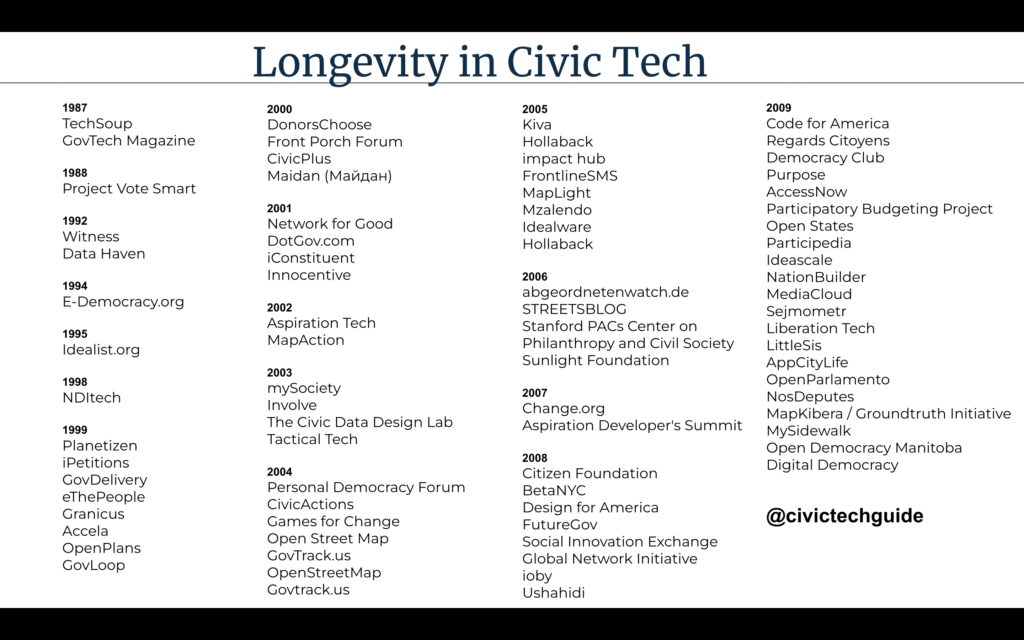
We’re eager to add to this list if there are groups we’ve overlooked — please leave a comment if that’s the case!
The median year of founding of our survey respondents was 2005. To repeat, 22 founders and executive directors replied to our survey, and 14 participated in our in-person deep dive. There was some overlap between these two groups, and because we allowed survey participants to opt for anonymity, we estimate that in all, we got information from a little more than 30 different leaders.
Of the organizations represented, about 70% were nonprofits and 30% for-profits and B corps. They spanned the gamut in terms of employee headcount.


And they had a variety of income sources, with some mentioning multiple sources, but the primary income for slightly more than half was user fees and foundation support.
LESSONS LEARNED
How have these civic tech founders managed to last 10 years or more?
Of all the lessons learned, the most commonly and passionately cited factors were the tenacity of founders and their team, developing a strong product or service offering that resonated with a clear market, and building strong relationships with well-aligned funders.

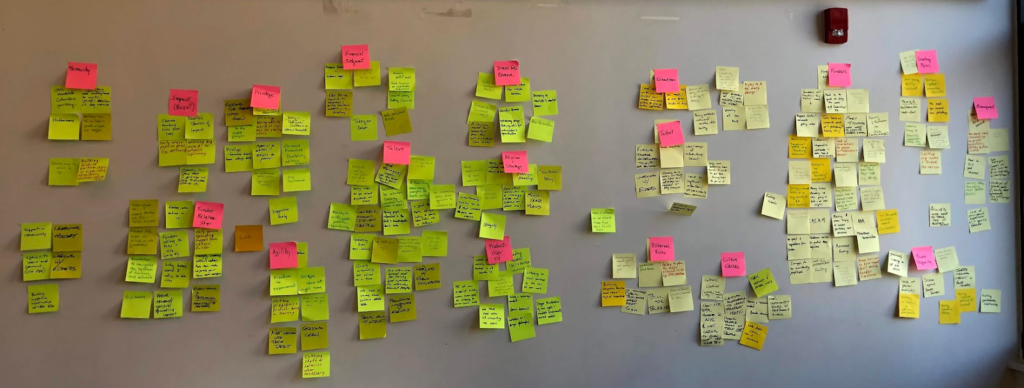
1. TENACITY

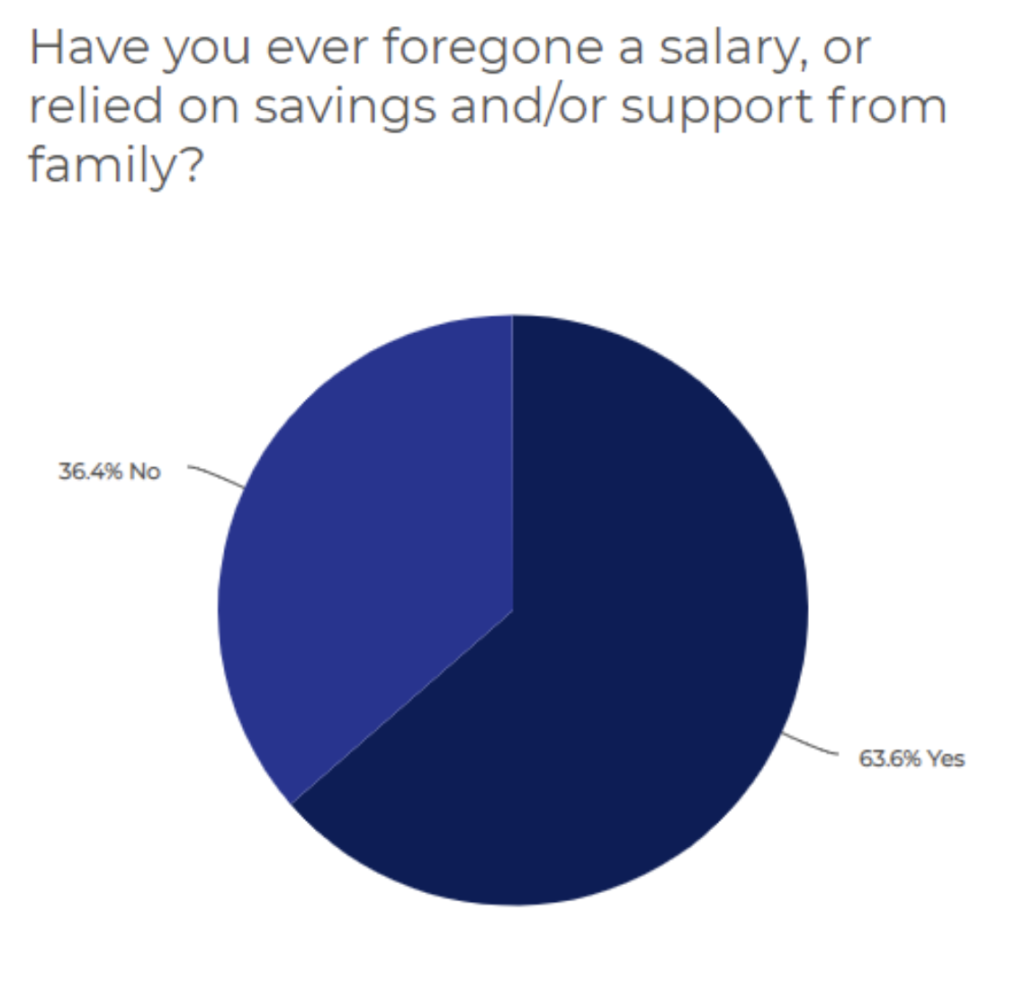
The first common theme was tenacity, or as one post-it note author put it, the “white knuckled tenacity of our founders.” There’s a lot inside of that, including smart management, the ability to pivot, and the courage to make tough financial decisions when necessary. Our survey results showed this clearly, but inside the workshop conversation what was also clear is that it’s not just the tenacity of founders, it’s also the resilience of teams. Great talent and strong community culture were key variables of success in the face of adversity. In other words, founders, don’t try to get through this by yourselves.
Nearly everyone we spoke to has experienced moments of thinking, “This might be it, we might be over.” Leaders of organizations that we might all agree are our success stories had those weeks, sometimes months, when they felt like failures.


Even among the largest among the organizations that we talked to — one that has more than 200 full-time employees — being willing and able to make tough decisions during economic downturns was key. Nearly 80% of the group has had to shut down programs due to a serious funding crisis, over 60% have had to furlough staff at some point, and just over half have had to consider closing entirely. These are the facts from organizations that have made it over ten years.
Life is not easy as a civic tech innovator. The majority of the founders we spoke to and surveyed had periods where they were unable to pay their own salary and were dependent on others for their living. We believe this finding has clear implications for founder diversity in civic tech.
2. PRODUCT-MARKET FIT
A second key lesson that came up again and again was the critical importance of strong product-market fit, and finding your audience niche. We’d argue that this is even more important now, in the midst of what is certain to be a challenging time.
Half of the organizations in our survey sample reported they’ve had to pivot, or significantly change their core offering, sometime in their journey.
Nailing that product-market fit, honing your offering to the audience that needs it, might well require change on your part. If the true need out there today is X, and you’ve been offering Y and Z, you need to re-imagine how you are going to help solve for X.
It’s understandable if you just want to hide inside right now, with so much trauma and uncertainty in play. But there is so much work to do. And we should be careful not to reinvent the wheel, but to ask and listen carefully to what people and organizations most need help with.
3. STRONG FUNDER RELATIONSHIPS
Last and not least, the majority of our respondents noted the importance of strong relationships with enlightened funders, both in the survey responses and in our deep dive workshop. In person, we were able to learn more about the many challenges that come with working with funders.
On the plus side: Long-running civic tech organizations have strong relationships with their funders. Among our survey respondents, over 83% feel their funders’ priorities and time horizons match their own organizations’. Of course correlation is not causation.

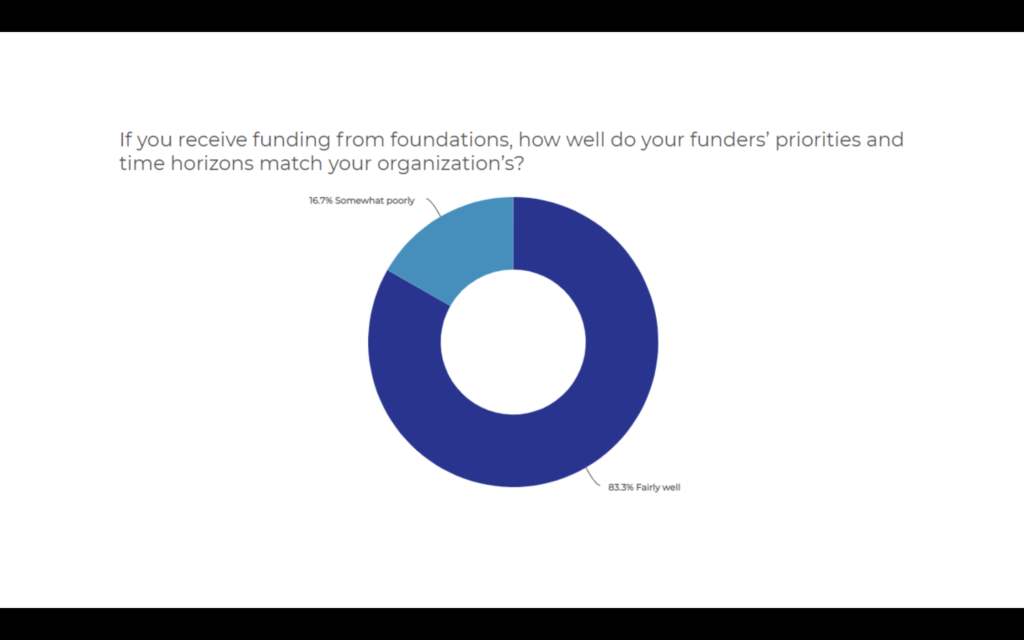
Another key ingredient to success in the funding puzzle is having funders who are willing to take risks or at least tolerate a level of risk. But many of our respondents also said that have diversified sources of income, or in other words, not having all their eggs in one funding basket, was vital to their success.
In terms of challenges, even successful civic tech founders report that fundraising can be a bear, mentioning problems like lacking connections to funders, needing to deal with some funders’ emphasis on whatever the “new thing” is at the moment and their tendency to reward the buzziest projects as opposed to the most useful or impactful, the ever-present challenges that come with restricted instead of general operating support, and a lack of understanding of the nonprofit sector on the part of some funders.

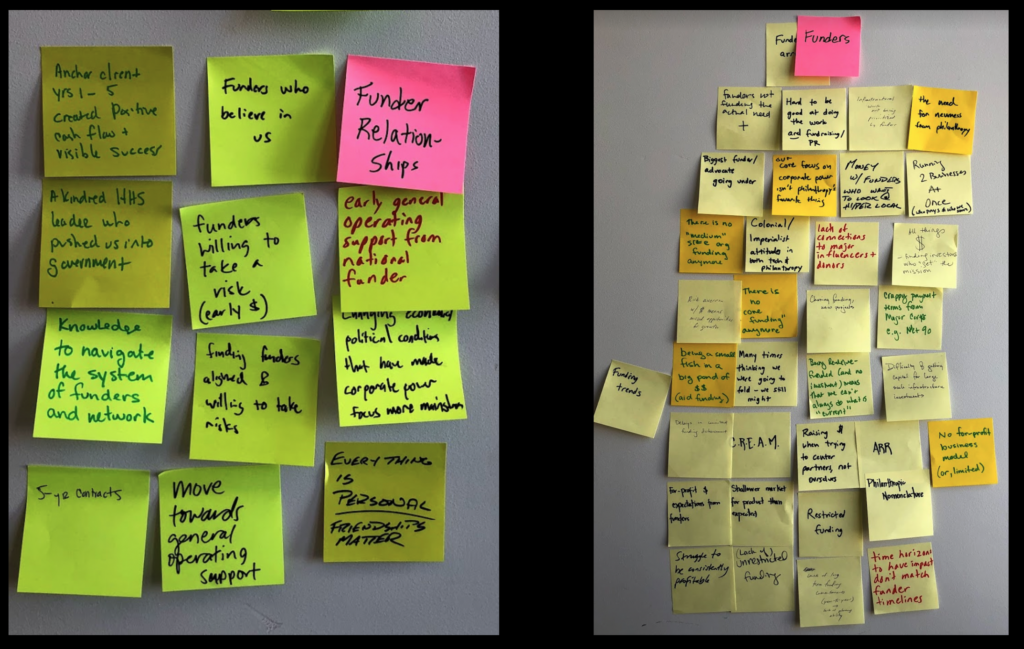
ADDITIONAL FINDINGS
Most of the groups (over 90%) have experienced large bursts in attention to their work, but it wasn’t always helpful to the mission. While 73.6% found it helpful or very helpful, over 26% found it had no effect or even negative effect.
The majority (71.4%) started their organizations without strategic plans, although that number is the inverse today: only 23.8% do not currently operate under a strategic plan. Of those who have a plan, though, only about 30% follow it “very carefully”.
Attention is overrated, and a double-edged sword. Large bursts of attention had little long-term benefit to organizations, according to their leaders, and are sometimes more of a distraction than a boon.
We were also surprised to see that many long-lasting organizations either didn’t have or didn’t follow strategic plans at the onset. It appears these are one of those things that comes along as organizations mature. Founders did place significant value on the management help and training they were able to procure.
THE COVID-19 CHALLENGE
COVID-19 is definitely shaking up some parts of philanthropy. We’re seeing statements from hundreds of large and small foundations promising to be more flexible as they help their grantees and programs survive the current crisis. For years, grantees have been asking foundations to provide more general operating support as well as greater flexibility in achieving their program goals. Now it looks like coronavirus is spurring many foundations to change their processes accordingly. It’s far to soon to say if it will be enough, but it’s certainly welcome news.
As we were preparing this talk for TICTeC, we wanted to honor and acknowledge the hard place many of us are in right now. Especially those of us leading organizations others depend on.
Right now, many of the long-running civic tech organizations we spoke to are dealing as best they can with the crisis. A quick scan shows some groups focused right now on hunkering down and figuring out how to take care of their staffs while starting to dip their toes into providing services virtually.
Some who are in the business of providing software platforms for civic organizing, have already made their tools free for governments, agencies and NGOs providing essential services and emergency response.
Some civic tech veterans are already organizing efforts to figure out how to augment government capacity with tech workers. Others are already at work figuring out how the US might move to a national vote-by-mail election.
Transparency watchdogs are shifting their monitoring efforts to try to ferret out corruption that may arise as governments inject trillions of dollars into relief programs. We’re seeing massive virtual hackathons and local civic tech and mutual aid groups figuring out how they can help local neighborhoods take care of people most in need.
It’s going to be easier for some groups to pivot than others. None of us really know what lies ahead. We hope our presentation on what has helped civic tech groups last, in the past, may give you some guidance or orientation on where we go next.
You can view the full TICTeC schedule, view the slidedecks and collaborative session notes, and watch the other sessions on YouTube.
Share this page:
- Click to share on WhatsApp (Opens in new window) WhatsApp
- Click to email a link to a friend (Opens in new window) Email
- Click to share on LinkedIn (Opens in new window) LinkedIn
- Click to share on Mastodon (Opens in new window) Mastodon
- Click to share on Threads (Opens in new window) Threads
- Click to share on Facebook (Opens in new window) Facebook
- Click to share on X (Opens in new window) X
